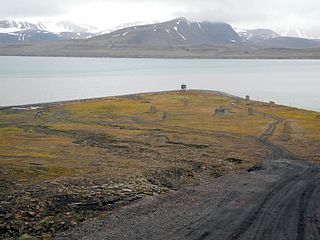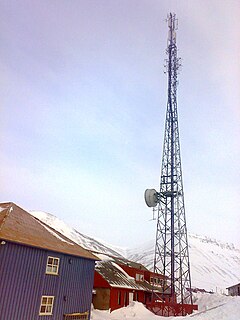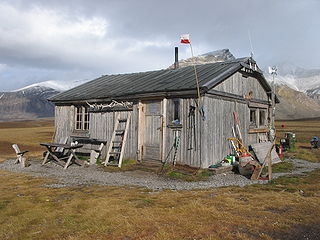Related Research Articles

Svalbard and Jan Mayen is a statistical designation defined by ISO 3166-1 for a collective grouping of two remote jurisdictions of Norway: Svalbard and Jan Mayen. While the two are combined for the purposes of the International Organization for Standardization (ISO) category, they are not administratively related. This has further resulted in the country code top-level domain .sj being issued for Svalbard and Jan Mayen, and ISO 3166-2:SJ. The United Nations Statistics Division also uses this code, but has named it Svalbard and Jan Mayen Islands.

Barentsburg is the second-largest settlement on Svalbard, with about 470 inhabitants (2015), almost entirely made up of ethnic Russians and Ukrainians.

Olav V Land is a peninsula in eastern Spitsbergen Island, Svalbard named after Olav V of Norway. It is covered by the Olav V Icefield, measuring about 4,150 square kilometres (1,600 sq mi).
Duells Corners is a hamlet in the town of Orchard Park in Erie County, New York, United States.

Oscar II Land is the land area between Isfjorden and Kongsfjorden on Spitsbergen, Svalbard. The 30 km (19 mi) long glacier Sveabreen divides Oscar II Land from James I Land.

Bünsow Land is a land area at the inner end of Isfjorden at Spitsbergen, Svalbard. It forms a peninsula between Billefjorden and Sassenfjorden and Tempelfjorden. Bünsow Land is named after Friedrich Christian Ernestus Bünsow.

Dickson Land is a land area between Isfjorden and Wijdefjorden at Spitsbergen, Svalbard. It forms a peninsula between the Isfjorden branches Billefjorden and Dicksonfjorden. Dickson Land is named after Oscar Dickson.

James I Land is a land area on the northwestern part of Spitsbergen, Svalbard. It is named after King James I of England and Scotland. The 30 kilometer long glacier Sveabreen divides James I Land from Oscar II Land.

Finneset is a peninsula located on the east side of Grønfjorden on Spitsbergen in Svalbard, Norway. It is located 2 kilometers (1.2 mi) south of Barentsburg. A whaling station was located there until 1905. From 1911 it became the site of the first wireless station in the Arctic, named Svalbard Radio from 19 September 1925. It was also a meteorological station operated by the Norwegian Meteorological Institute. Both services moved to Longyearbyen on 1 September 1930. It is named for being a fine place to land a ship.

Svalbard Radio is a coast radio station established in 1911 at Finneset in Svalbard, Norway. In 1930, it moved to Skjæringa in Longyearbyen and since 1975 it has been co-located with Svalbard Airport, Longyear. It has been remote-controlled from Bodø Radio since 2006.
Sassendalen is a valley at Spitsbergen, Svalbard. The valley is among the largest valleys of Svalbard, and continues westwards into Sassenfjorden. Part of the valley divides Sabine Land and Nordenskiöld Land. The river Sassenelva runs through the valley.
St. Jonsfjorden is a fjord in Oscar II Land at Spitsbergen, Svalbard. It has a length of 21 kilometer, and opens westwards into the strait of Forlandsundet. Several glaciers debouche into the fjord, including Gaffelbreen and Konowbreen from the north, a merge of Osbornebreen, Devikbreen, Vintervegen, Paulbreen and Bukkebreen at the bottom, and Vegardbreen, Charlesbreen and Bullbreen from the south.
Osbornebreen is a glacier in Oscar II Land at Spitsbergen, Svalbard. It has a length of 21 kilometers, merges with the glaciers Devikbreen, Klampebreen and Vintervegen, and debouches into St. Jonsfjorden. The mountain ridge Goldschmidtfjella forms a six kilometer long nunatak in the glacier.
Tunabreen is a glacier stream at Spitsbergen, Svalbard. The glacier is about 23 kilometers long, and divides Sabine Land from Bünsow Land. It starts from Lomonosovfonna, flows southwards between the mountains of Langtunafjella and Ultunafjella, merges with Von Postbreen, and the combined glacier debouches into Tempelfjorden.
Agardhfjellet is a mountain in Sabine Land at Spitsbergen, Svalbard. It has a height of 587 m.a.s.l., and is located at the western side of Storfjorden, east of Myklegardfjellet. The mountain is named after botanist Jacob Georg Agardh. It also includes the peak Agardhaksla.
Sveigbreen is a glacier stream in Sabine Land at Spitsbergen, Svalbard. It has a length of about eleven kilometers, and extends the southern part of the ice cap Hellefonna, south of Kropotkinfjellet. The glacier is one of the two main sources to the river Agardhelva, which flows through Agardhdalen towards Agardhbukta.
Sefströmbreen is a glacier in James I Land at Spitsbergen, Svalbard. It is debouching into Ekmanfjorden at the northern side of Isfjorden. The glacier is named after Nils Gabriel Sefström. During a surge in 1896 the glacier deposited large moraine ridges in the inner part of the fjord, and these can be seen at the islands of Coraholmen and Flintholmen. Sefströmbreen is included in the Nordre Isfjorden National Park.
Akademikarbreen is a glacier in Olav V Land at Spitsbergen, Svalbard. It covers an area of about 500 square kilometers and is located east of Backlundtoppen and Svanbergfjellet. The glacier extends from Billefjorden to the eastern coast, and borders to Lomonosovfonna, Negribreen and Kvitbreen. It is named after two members of Russian Academy of Science.
Kvitbreen is a glacier in Ny-Friesland at Spitsbergen, Svalbard. It located south of Newtontoppen, and is connected with the glacier of Veteranen at the other side of Trebrepasset.

Petuniabukta is a bay in Dickson Land at Spitsbergen, Svalbard. It constitutes the northern branch of Billefjorden. The bay is named after the Scottish vessel SS Petunia. Northwest of the bay is the valley of Hørbyedalen and the glacier of Hørbyebreen.
References
- ↑ "Lomonosovfonna (Svalbard)". Norwegian Polar Institute . Retrieved 30 June 2013.
- ↑ Lauritzen, Per Roger, ed. (2009). "Lomonosovfonna". Norsk Fjelleksikon (in Norwegian). Friluftsforlaget. ISBN 978-82-91-49547-7.
Coordinates: 78°44′54″N17°35′12″E / 78.74833°N 17.58667°E
| This article about a glacier in Spitsbergen is a stub. You can help Wikipedia by expanding it. |